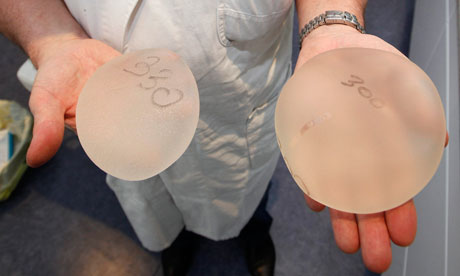
There are eyewatering tales dating back to the late 19th century of paraffin injections, ox cartilage prosthetics and even ivory and glass balls, but cosmetic breast enlargement first became a realistic option for women in 1962, when Texan housewife and mother of six Timmie Jean Lindsey was persuaded to have silicone-filled implants fitted under the skin of her breasts.
"I thought, oh, I'd like that" Lindsey told the Guardian in 2008. "I'd like them to be perkier."
Half a century after her pioneering surgery, hundreds of thousands of women around the world have followed her lead, opting for perkier, larger or more even breasts – or simply seeking to replace them after surviving cancer.
There have been repeated scares and controversies over the decades, but medics insist the procedure is very safe if performed by qualified and well-regulated surgeons.
But while "boob jobs" are the most popular cosmetic procedure performed in the UK, according to the British Association of Aesthetic Plastic Surgeons, the exact number performed is difficult to tally. BAAPS-registered surgeons performed 9,418 cosmetic breast augmentations in 2010, and a spokeswoman estimated the organisation represents 33%-40% of cosmetic surgeons in the UK, but it can be no more specific.
NHS figures for 2008 show that of the 15,479 women in England who had mastectomies following breast cancer, 3,216 opted for immediate reconstruction (others had reconstruction later); separately, it found that only 38% of those having reconstructions had opted for prosthetic implants, as opposed to other reconstructive techniques. The Medicines and Healthcare products Regulatory Agency estimates that reconstructive surgery accounts for less than 5% of the procedures performed each year.
A reasonable estimate, in other words, is that around 25,000 British women a year have breast implants – although that won't account for the growing number opting to go abroad for surgery.
What everyone does agree on is that the numbers have risen rapidly and continue to do so. Doctors speak of a threefold increase over the past decade of women seeking the surgery; the BAAPS figure of 9,418 represented a rise of more than 10% on the year before.
According to Nigel Mercer, a consultant plastic surgeon and former president of the society, that is to do with the increased availability and affordability of the procedure. "It's simply no longer something that people view as involving major complications – almost as though the public feel that anyone can do a augmentation. So the complexity of the procedure has been downgraded in the public eye." Breast surgery is now seen as an entirely routine procedure, he said, like having tonsils out.
Professor Simon Kay, a consultant plastic and hand surgeon at St James's University Hospital in Leeds, agrees. "The thing about breast augmentation is that it's a very safe procedure, very reliable, with a very high rate of satisfaction, and a very low complication rate."
The number of scares about the procedure over the decades, he says, have meant that "they have been more closely looked at than any other implanted material".
Certainly the history of the boob job has been a troubled and at times controversial one. Twenty years after Lindsey had her surgery, silicone implants were withdrawn in the US after 170,000 women brought a class action against the manufacturers, the Dow Corning corporation, complaining of ruptures or leakages and, often, severe pain; although other governments judged them safe, they were not re-approved by the US authorities until 2006.
In the interim, alternative technologies brought their own problems for American women: soyabean oil implants, considered a safer alternative to silicone, were introduced in 1995 but withdrawn four years later.
In Britain polyurethane-coated silicone implants were withdrawn in 1991, amid fears that they could increase the risk of cancer, although research subsequently showed that the risk is less than one in a million and the implants were reintroduced in 2005. Silicone gel implants were ruled non-toxic by British government advisers in the late 1990s, following US allegations about ruptured implants causing joint pains and chronic fatigue syndrome.
Though this chequered history has left a "cultural residue" in terms of perceived risk, said Kay, who is communications chair of the British Association of Plastic, Reconstructive and Aesthetic Surgeons, in his experience it is he, rather than his patients, who raises the question of potential risks from the surgery — which he stresses, thanks to technological advances, are – now very small if the surgery is performed by good surgeons.
But an emphasis on risk alone can overlook the health benefits of implants, he argued. "It's always slightly unreasonable for a man to lecture a woman about the benefits of being feminine, but if you have no breasts or completely empty breasts I'm told you don't feel feminine, there can be self confidence issues. There's a perception that women having breast implants are all bobble-headed bimbos looking for enormous pneumatic breasts, but this is not the case. They are ordinary women."
Rather than a stampede of young women seeking to emulate glamour models, he said, ifanything those coming to see him tended to be post-menopausal women in their 50s and 60s, not younger ones trying to emulate glamour models, he said.
For the smaller number of women who have had implants following cancer treatment, said Emma Pennery, clinical director at Breast Cancer Care, safety scares around implant safety are particularly troubling. "I think it's very difficult for women who have had a breast reconstruction on top of their cancer to then have concerns about the safety of their implant."
The safety risk may be very small, she said, "But irrespective of the reality, what is horrid is having the fear. People with breast cancer already face the loss of their breast, the ordeal of a reconstruction, probably ongoing cancer treatments as well. They have a lot to cope with, and suddenly they are potentially to have some fear, which is an extra burden."

